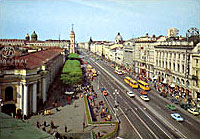 The Nevskiy Prospekt is the main thoroughfare of St. Petersburg that starts from the Admiralty Prospekt and ends at the Alexander Nevsky Square. It is 4.5 km long and 25 - 60 meters wide. The part between the Square of Insurrection and the Alexander Nevsky Square is traditionally called Old Nevsky Prospekt.
The Nevskiy Prospekt is the main thoroughfare of St. Petersburg that starts from the Admiralty Prospekt and ends at the Alexander Nevsky Square. It is 4.5 km long and 25 - 60 meters wide. The part between the Square of Insurrection and the Alexander Nevsky Square is traditionally called Old Nevsky Prospekt.
The Moyka River (the Narodny Bridge), the Fontanka River (the Anichkov Bridge), and the Griboedova Canal (the Kazansky Bridge) cross Nevsky Prospekt.
The Nevsky Prospekt appeared in 1710 as two roads in boggy forest leading from the Admiralty and from the Alexander Nevsky Monastery to the Old Novgorod high road.
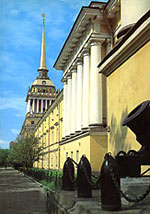
The part from the Admiralty to the present Square of Insurrection was known as a Big Prospect which was the main entrance to the city. For the first time the Admiralty appeared in St. Petersburg in 1704. It was rebuilt several times but its basic design has never been changed. Its present look was given to it in 1805-1811 by architect A. Zakharov. The Admiralty was used for ship-building until the 1860s. Now the Naval Engineering College is in the building.
In the 1730s the road was called the Neva Prospect. In the 1760s a single thoroughfare was formed, which from the end of the 1700s, acquired the present name of Nevsky Prospekt.
The Fountain river was the boundary of the city in the 18th century. It supplied water for the fountains of the Summer Garden and that's the way the river got it's name. The bridge is decorated with four different equestrian statues - taming of the horse. During the siege the statues were buried in the ground but a splinter of a shell hit one of the pedestals.
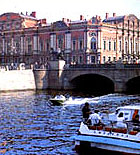 The Anichkov Palace is one of the oldest on the street. It was built in 1740 to the order of Elizabeth for one of her favorites - Count Razumovsky, then changed hands many times but belonged to the Romanov's. Now it belongs to the secondary school children. There are various amateur societies after school classes which are free of charge.
The Anichkov Palace is one of the oldest on the street. It was built in 1740 to the order of Elizabeth for one of her favorites - Count Razumovsky, then changed hands many times but belonged to the Romanov's. Now it belongs to the secondary school children. There are various amateur societies after school classes which are free of charge.
In the palace garden there is a monument to Catherine II. These are figures of Catherine's contemporaries at the feet of the Empress.
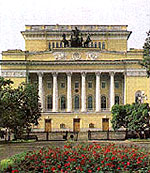 The Alexandrinsky Theatre is the oldest professional theatre of Russia that dates from 1756. The building was constructed to the design of K. Rossi in 1832. It was one of the architectural masterpieces among theatre houses of the 19th century. The theatre and the short street (which bears the architect's name - Rossi) owes part of its beauty to this architect.
The Alexandrinsky Theatre is the oldest professional theatre of Russia that dates from 1756. The building was constructed to the design of K. Rossi in 1832. It was one of the architectural masterpieces among theatre houses of the 19th century. The theatre and the short street (which bears the architect's name - Rossi) owes part of its beauty to this architect.
There is no monument to Rossi unfortunately. So it is only fair that the street with the buildings constructed by him bear his name. It is noted that the classical style symmetry was observed. The length is more than 10 times its width and the width of the street is equal to its height.
Merchants Yard The entire block to the left is taken by Merchants Yard - "Gos.D.". It's one of the biggest department stores in the city and it's one of the oldest too. It was built in the middle of the 18th century by Vallen Delamot. It was a model for other stalls, built at the end of the 18th century in SPb and in other cities Square of Arts.
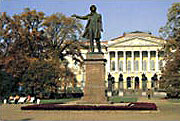 It is called so because there are 3 theatres and 2 museums located in the square. The state Philharmonic is the oldest in the country. Its symphony orchestra enjoys world fame. The building is the former Assembly Hall for Russian nobility. Musical comedy theatre was one of the three theatres, which were opened during the siege.
It is called so because there are 3 theatres and 2 museums located in the square. The state Philharmonic is the oldest in the country. Its symphony orchestra enjoys world fame. The building is the former Assembly Hall for Russian nobility. Musical comedy theatre was one of the three theatres, which were opened during the siege.
The Russian museum (formerly Michael's palace) was built by Rossi.
It has the Maly Opera and the Ballet Theatre. Now it bears the name of Musorgsky. The theatre is famous for being the first to stage the works of modern composers. In the center of the square there is now a monument to Pushkin.
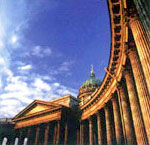 Kazan Cathedral
Kazan Cathedral
This is the Cathedral of Our Lady of Kazan. It was built from 1801 to 1811 by Voronihin.
Its northern wall is decorated with 114 columns. The traditional shape of the Russian church is the cross.
The grey corner building to the right is the largest book store in St. Petersburg. A number of publishing offices occupy the upper floors of the building.
The building was constructed for the Singer sewing machine company in the beginning of the 20th century. It was built of stone, metal, and glass and was the first fireproof building in the city.
The Stroganoff palace was built in 1764 Rastrelly in the Russian Baroque style. The green building, which overlooks both the main street and the river, is the former Count Stroganoff's palace. The palace retains most of its original look. Stroganoff was the president of the Academy of Fine Arts.
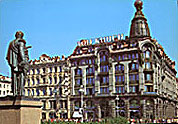 The Aeroflot booking office was built in 1912. It is a replica of the Palace of the Doges in Venice. The original tenant was a bank, now it houses the Russian Airlines agency and a few shops. The Palace bridge was built in 1916. It is a drawbridge and its bridge is lifted every night.
The Aeroflot booking office was built in 1912. It is a replica of the Palace of the Doges in Venice. The original tenant was a bank, now it houses the Russian Airlines agency and a few shops. The Palace bridge was built in 1916. It is a drawbridge and its bridge is lifted every night.
From this bridge opens a good view of the Admiralty. It was built in the shape of wide Latin letter U open to the Neva. The buildings and apartments here are some of the most expensive ones, but the owners wanted to live as close to the Winter Palace as possible.